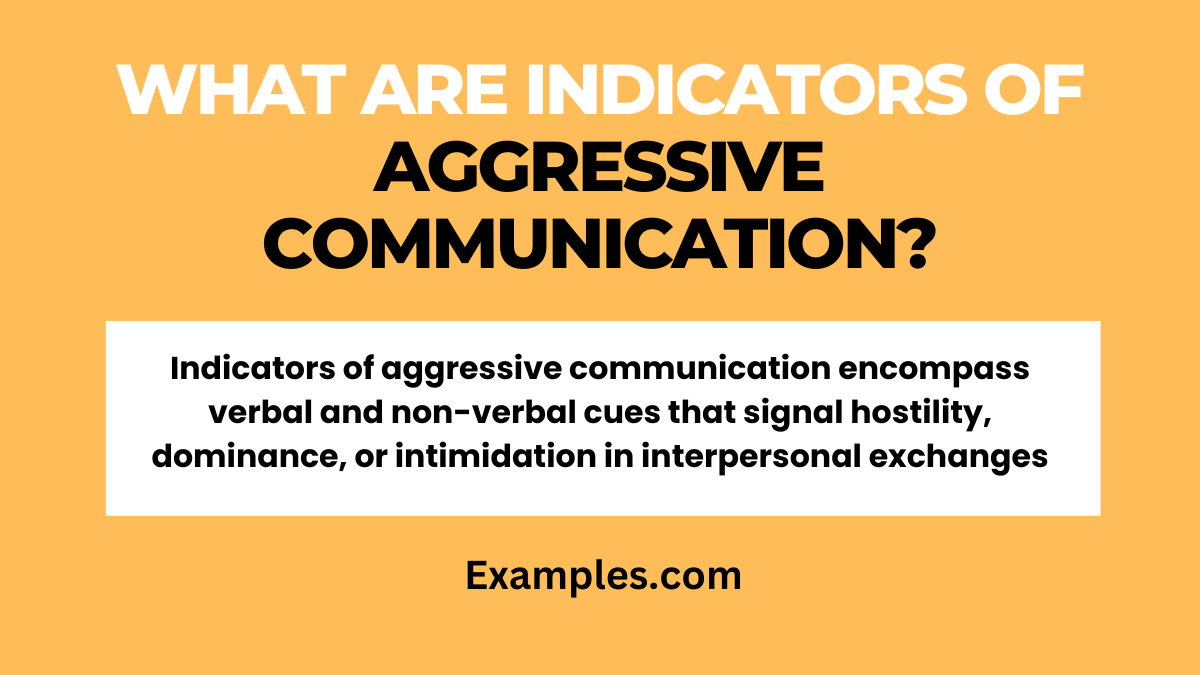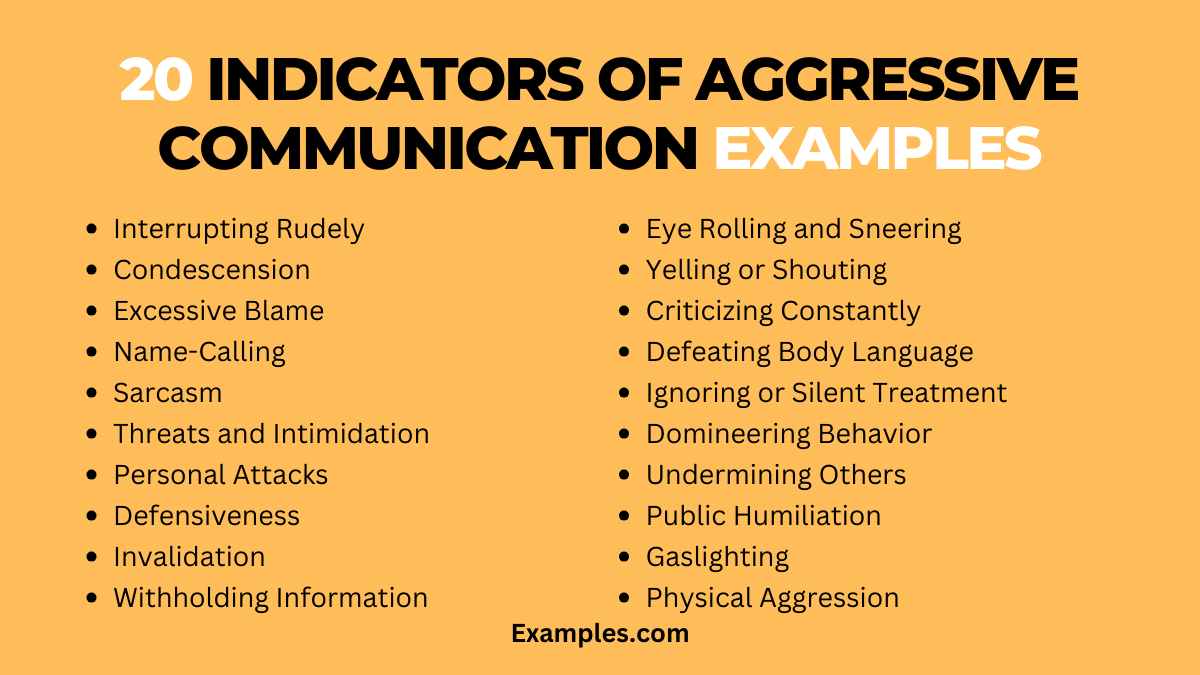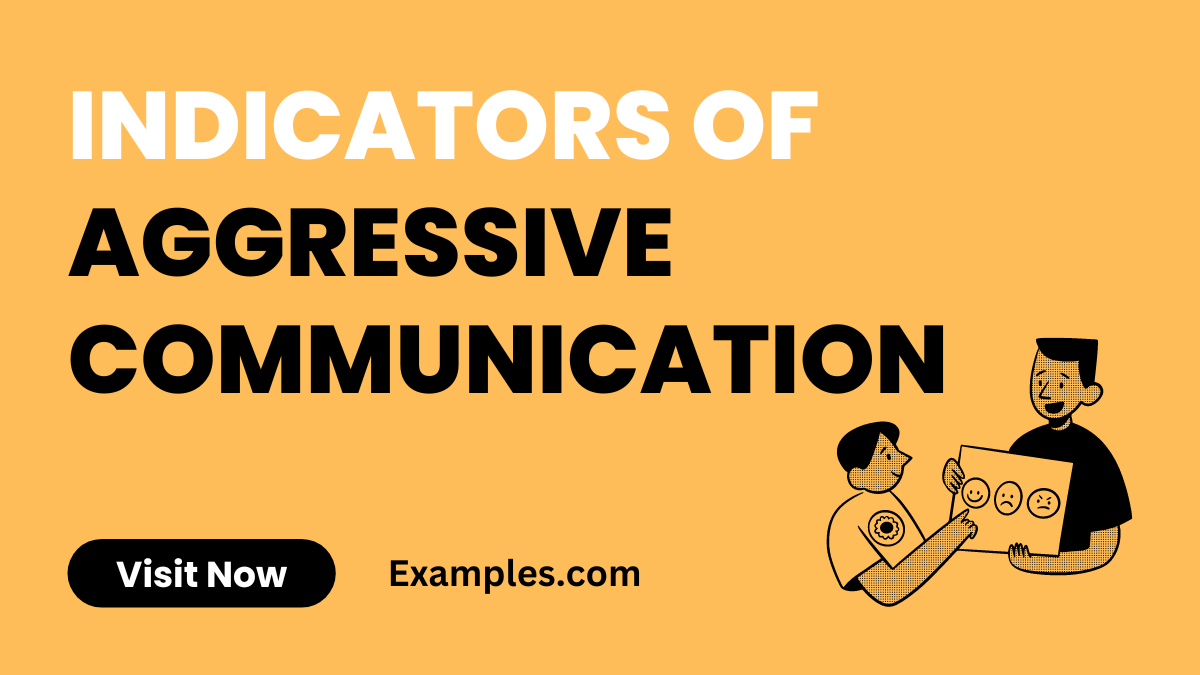Indicators of Aggressive Communication
Unlock the intricacies of human interaction with our comprehensive guide on Indicators of Aggressive Communication. Delve into real-world situations as we explore Communication Examples that shed light on aggressive behaviour in relationships and the workplace. This in-depth analysis not only highlights warning signs but also equips you with valuable insights and strategies for fostering a more positive and assertive communication style. Enhance your interpersonal skills and navigate conflicts with confidence through this illuminating guide.
What are Indicators of Aggressive Communication?

Indicators of aggressive communication encompass verbal and non-verbal cues that signal hostility, dominance, or intimidation in interpersonal exchanges. These signs may include raised voices, harsh language, dismissive gestures, and a refusal to consider alternative viewpoints. Recognizing these indicators is crucial for fostering healthier communication and resolving conflicts constructively. In this guide, we unravel the nuances of aggressive communication, offering a clear understanding of its tell-tale signs and implications.
20 Indicators of Aggressive Communication Examples
Explore the 20 indicators of aggressive communication in this insightful guide, shedding light on verbal and non-verbal cues that signal hostility. Gain a nuanced understanding of these indicators to navigate conflicts effectively and foster healthier interactions.

- Interrupting Rudely:
Example: Cutting someone off mid-sentence with dismissive remarks like, “I don’t care what you think.” - Condescension:
Example: Speaking down to others, belittling their contributions, “You wouldn’t understand.” - Excessive Blame:
Example: Shifting blame aggressively, saying, “This failure is entirely your fault.” - Name-Calling:
Example: Using derogatory terms to address someone during a disagreement, “You’re such an idiot.” - Sarcasm:
Example: Mocking tone or ironic comments, like, “Wow, you’re a genius, aren’t you?” - Threats and Intimidation:
Example: Using phrases like, “You better do what I say, or else…” - Personal Attacks:
Example: Attacking someone’s character instead of addressing the issue,, “You’re just lazy.” - Defensiveness:
Example: Avoiding responsibility by becoming defensive, saying, “It’s not my fault.” - Invalidation:
Example: Dismissing someone’s feelings, saying, “You’re overreacting; it’s not a big deal.” - Withholding Information:
Example: Refusing to share crucial details during communication, creating frustration. - Eye Rolling and Sneering:
Example: Displaying contempt through facial expressions, undermining others. - Yelling or Shouting:
Example: Raising your voice aggressively to overpower the conversation. - Criticizing Constantly:
Example: Offering unsolicited negative feedback on every action, creating a toxic atmosphere. - Defeating Body Language:
Example: Slumping posture and dismissive gestures, signalling disinterest. - Ignoring or Silent Treatment:
Example: Refusing to communicate as a form of punishment. - Domineering Behaviour:
Example: Always needing to control conversations and decisions. - Undermining Others:
Example: Subtly sabotaging someone’s efforts, fostering a competitive environment. - Public Humiliation:
Example: Criticizing or mocking someone in a group setting. - Gaslighting:
Example: Manipulating facts to make someone doubt their own reality. - Physical Aggression:
Example: Using physical force or gestures to intimidate during communication.
Indicators of Aggressive Communication in Relationships
Uncover the warning signs of aggressive communication within relationships. This guide explores subtle cues that can strain personal connections. Enhance your understanding to foster a healthier and more respectful interaction.

- Silent Treatment:
Example: Ignoring a partner for days after a disagreement, creating emotional distance. - Overbearing Control:
Example: Dictating every aspect of a partner’s life, eroding personal autonomy. - Excessive Jealousy:
Example: Accusing a partner without cause, damaging trust and intimacy. - Manipulative Guilt-Tripping:
Example: Using guilt to control actions, such as, “If you loved me, you’d do this.” - Passive-Aggressive Remarks:
Example: Making sarcastic comments instead of addressing concerns directly.
Indicators of Aggressive Communication at Workplace
Navigate the complexities of workplace dynamics by recognizing indicators of aggressive communication. Uncover signs that may disrupt professional relationships and create a toxic work environment.
- Public Humiliation:
Example: Criticizing an employee in a meeting, damaging morale and trust. - Micromanaging:
Example: Constantly monitoring every aspect of an employee’s work, stifling creativity. - Dismissive Tone:
Example: Speaking condescendingly, diminishing the value of colleagues’ contributions. - Blaming Without Cause:
Example: Assigning blame for failures without evidence, creating a hostile atmosphere. - Sabotaging Others’ Work:
Example: Undermining a colleague’s project to gain a competitive edge.
What are Some Indicators of Aggressive Communication?
Navigating the intricacies of human interaction requires a keen awareness of potential signs of aggression. Recognizing these indicators empowers individuals to foster healthier communication. In this guide, we delve into various cues and signals that may signify aggressive communication, both verbally and non-verbally.
Verbal Indicators:
- Defensive Language:
Example: “It’s not my fault; you always blame me!” - Criticism and Blame:
Example: “This failure is entirely your responsibility.” - Name-Calling:
Example: “You’re such a failure; nothing you do is right.” - Interrupting Rudely:
Example: “Why are you even talking? Your ideas are pointless.” - Sarcasm:
Example: “Great job on that project—said no one ever.”
Non-Verbal Indicators:
- Aggressive Body Language:
Example: Intense eye contact, clenched fists, and invading personal space. - Facial Expressions:
Example: Eye rolling, sneering, or scowling during conversations. - Tone of Voice:
Example: Speaking loudly, sharply, or with a mocking tone. - Physical Aggression:
Example: Slamming doors, throwing objects, or other threatening gestures. - Ignoring or Silent Treatment:
Example: Refusing to communicate and creating an atmosphere of tension.
What are the Indicators of Aggressive Behaviour in Conflict Resolution?
Conflict resolution is a delicate process, and indicators of aggression can hinder its effectiveness. Understanding these signs is crucial for creating a collaborative environment where conflicts can be resolved constructively.
- Refusal to Compromise:
Example: “I won’t give an inch. It’s my way or no way.” - Personal Attacks:
Example: “Your ideas are stupid, and you’re incompetent.” - Defensiveness:
Example: “I don’t need to change; the problem is with everyone else.” - Threats and Ultimatums:
Example: “If you don’t agree, you’ll regret it.” - Escalation of Tone:
Example: Starting calmly but raising voice and aggression as the discussion continues.
In conclusion, understanding the subtle indicators of aggressive communication is vital for fostering healthier relationships and workplaces. This comprehensive guide has explored verbal and non-verbal cues, providing valuable insights and examples. By recognizing these signs, individuals can navigate conflicts with greater sensitivity, contributing to a more positive and harmonious communication environment in both personal and professional spheres.



